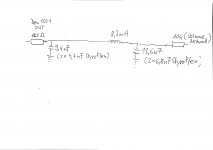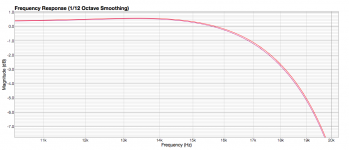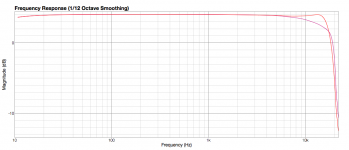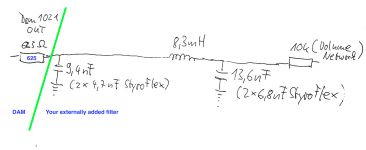Hi
Since I posted that originally in the wrong thread, I post it again, because I think that might be interesting for some....
I was trying out trueNOS on my DAM a few weeks ago, since I never heard a NOS Dac before I was curious about it. I immediately liked it a lot, relaxed and a bit euphonic for my ears. But after a while I found that something is not quite right, just a tiny little bit and hard to pinpoint, maybe the frequency response or the supersonic mirrors.
So I thought, a proper NOS Dac needs an analogue filter, best with a little peak to flatten the HF response.
So I simulated a simple 3 Pole chebychev like lowpass, that would accomplish the task and built it.
Simulation translated pretty well, my implementation rolls of a little earlier, but that does not bother me.
My NOS DAM1021 is now pretty flat up to 15k and -3dB is 18k. My old ears go up to 14k with a sine wave, so that is OK with me.
Simulation says, response is down around 20dB at 40k, but I guess it is more in reality. That does not sound much, but the resulting voltage is only a tenth of the unfiltered voltage, that should take a lot of burden of the following equipment.
Since I use a 10k volume switching network with relays I have a defined impedance that the filter works into. 625 ohms of the ladder is the source impedance, granted you use the unbuffered output.
The capacitors are old Siemens Styroflex, very, very nice caps they are and the inductor is a TDK from a surplus store, I had to test a few to have a more or less matched pair, they where all over the map.
I am listening for a few days now and the sound is great, the compromise seems gone, pure joy. I can listen forever and without a hint of fatigue, which is something I am very sensitive for.
Of course highres files have a compromised frequency response, but 99,9 precent of my material is 44,1 k anyway and if I keep the filter I might make it switchable.
It is cheap and easy to built, I can just recommend to try that out and maybe modify it to your liking if you are a fan of no oversampling in DACs.
First Picture the schematics
Second one is the response of both channels
Third is is NOS vs. NOS with the filter
Everything recorded into the analogue input of an old macbook and measured with fuzz measure.
Since I posted that originally in the wrong thread, I post it again, because I think that might be interesting for some....
I was trying out trueNOS on my DAM a few weeks ago, since I never heard a NOS Dac before I was curious about it. I immediately liked it a lot, relaxed and a bit euphonic for my ears. But after a while I found that something is not quite right, just a tiny little bit and hard to pinpoint, maybe the frequency response or the supersonic mirrors.
So I thought, a proper NOS Dac needs an analogue filter, best with a little peak to flatten the HF response.
So I simulated a simple 3 Pole chebychev like lowpass, that would accomplish the task and built it.
Simulation translated pretty well, my implementation rolls of a little earlier, but that does not bother me.
My NOS DAM1021 is now pretty flat up to 15k and -3dB is 18k. My old ears go up to 14k with a sine wave, so that is OK with me.
Simulation says, response is down around 20dB at 40k, but I guess it is more in reality. That does not sound much, but the resulting voltage is only a tenth of the unfiltered voltage, that should take a lot of burden of the following equipment.
Since I use a 10k volume switching network with relays I have a defined impedance that the filter works into. 625 ohms of the ladder is the source impedance, granted you use the unbuffered output.
The capacitors are old Siemens Styroflex, very, very nice caps they are and the inductor is a TDK from a surplus store, I had to test a few to have a more or less matched pair, they where all over the map.
I am listening for a few days now and the sound is great, the compromise seems gone, pure joy. I can listen forever and without a hint of fatigue, which is something I am very sensitive for.
Of course highres files have a compromised frequency response, but 99,9 precent of my material is 44,1 k anyway and if I keep the filter I might make it switchable.
It is cheap and easy to built, I can just recommend to try that out and maybe modify it to your liking if you are a fan of no oversampling in DACs.
First Picture the schematics
Second one is the response of both channels
Third is is NOS vs. NOS with the filter
Everything recorded into the analogue input of an old macbook and measured with fuzz measure.
Attachments
Last edited:
Looks great! I've been advocating a similar CLC filter between DAC and I/V stage for a while now, encouraging to see another explorer reaping the benefits
Of course I found a few of your postings while researching that stuff
I find -3db @18kHz as sounding completely unacceptable, aging ears or not. You really need a sinx/x filter for NOS or alternatively have to correct this in FIR.
Of course people have different hearing abilities, but there is really not much musical information up there...
Vinyl, FM radio, a lot of famous microphones, quite a few areas in audio do not care about 18k. And I think for a reason.
I do not hear any problem frequency wise whatsoever.
In my experience as a part time recording engineer I always found filtering even outside the audioband, no matter if low or high cut detrimental to the sound. But if necessary I always prefer passive analogue vs digital. Sounds more musical to me...
Most mastering studios use very expensive analogue equalizers because of musicality and not because of technical perfection. Otherwise digital would be used exclusively.
You listened to a filter flat to 15kHz and -3dB at 18kHz?
Of course not. My opinion is based on lots of experience with phono correctors and transformer coupled circuits which sometimes exhibit mild irregularities in this range, often in the region of a db or two. It is amazing how audible this is, whether the range is subdued or amplified. For the record i cannot hear 18kHz, or anything close, but filters also introduce phase effects at lower frequencies.
It can certainly be argued that a specific amplification chain works and sounds better when out of band signals at the source are severely limited. Such amps for me are simply defective.
I also have nil interest in starting a useless argument, people are free to bandwidth limit music down to a telephone booth appliance for all i care
Well, that filter is for shure audible, but so is the digital upsampling filter of your regular dac chip, I am just stating, that for me, this one sounds better. And you could argue, that bandlimiting at 20k or 18k is not much different, both frequencies are far away from a 6k telephone filter.
It is so easy to build... you won’t loose much trying it out, than you can tell me that I have tin ears.
It is so easy to build... you won’t loose much trying it out, than you can tell me that I have tin ears.
since I never heard a NOS Dac before I was curious about it. I immediately liked it a lot, relaxed and a bit euphonic for my ears.
We have to embrace the fact that people hear and interpret differently. I have heard about a dozen NOS dacs and they all, without exception sounded dull to me. Irrespective of the dac chip type. Of course there were other issues with the sound as well, but the dull highs were always common.
As for the 1021, none of the filters i tried sounded worse than the new nos, yet apparently some people have the opposite view. The various Totaldacs, despite of being NOS share none of this dullness and i see a probable reason for this in the sinx/x filter, which of course can also be implemented in the analogue domain (Zanden?).
I have heard about a dozen NOS dacs and they all, without exception sounded dull to me. Irrespective of the dac chip type. Of course there were other issues with the sound as well, but the dull highs were always common.
Its relatively rare to find a NOS DAC that does droop correction for 44k1. I think perhaps AMR has one or more (Thorsten has been a proponent of correcting droop) but I don't know of any other commercial offerings that do it. Ah yes, TotalDac does I think have an option to switch on correction, done with an FIR filter I believe.
Right (On some publication it was 640 ohms on the ladder, but maybe that changed over time), and the 10k terminating resistance should have a ground symbol on the other side....Correct?
//
to raise the cutoff frequency a little I would have rather used an inductor of 7,5 mH or so, but had none available, it was just a trial though, but turned out fine...
Last edited:
A first order LP filter would not dampen 40k very much and on the website they do not talk about a filter at all, so....To the best of my knowledge no, but that does not mean there is no cap at the output of the ladder.
Interesting, this 10000 dollar DAC seems to please everybody who listens to it, so the mirrors seemingly do not count.
I am sure my Amp (The Cubie3 design from Juma based on the Pass F5) does not care about those high frequencies, but I suspect the tweeters might produce some intermodulation distortion due to that uncorrelated hf rubbish, but have obviously no evidence...
I do have a few questions here.
Here is an except from the dam manual:
“The dam1121 upsamples everything to the final 2.8/3.1 Mhz DAC sample rate in two steps, there are three different filters in the dam1121”
I know that NOS filters were made, also by the so called “filter Meister Paul”. The latest was the NewNOS. As I understood from reading the dam1021 filter thread this inserts some zeros but it is still up sampling. If I’m wrong I happy take “no you’re wrong” for an answer.
Till then I’m not sure if the Dam can be considered as a true NOS DAC.
Second question. If you want to filter the high frequency’s with an extra filter after the DAM board, did you remove the onboard C? If not you're filtering twice, on purpose. I do have no problems with that but one seems useless then no?
Sorry if I’m repeating myself of get on someone’s nerves with this RC or “output” C Filter thing.
Here is an except from the dam manual:
“The dam1121 upsamples everything to the final 2.8/3.1 Mhz DAC sample rate in two steps, there are three different filters in the dam1121”
I know that NOS filters were made, also by the so called “filter Meister Paul”. The latest was the NewNOS. As I understood from reading the dam1021 filter thread this inserts some zeros but it is still up sampling. If I’m wrong I happy take “no you’re wrong” for an answer.
Till then I’m not sure if the Dam can be considered as a true NOS DAC.
Second question. If you want to filter the high frequency’s with an extra filter after the DAM board, did you remove the onboard C? If not you're filtering twice, on purpose. I do have no problems with that but one seems useless then no?
Sorry if I’m repeating myself of get on someone’s nerves with this RC or “output” C Filter thing.
Last edited:
Till then I’m not sure if the Dam can be considered as a true NOS DAC.
If you look at it as a black box, yes, it behaves exactly as a NOS dac. If you dig into the inner workings, then not so NOS. I am unsure how this answers the question whether it is true NOS or not. Soundwise i find it to be a bad NOS imitation.
If you look at it as a black box, yes, it behaves exactly as a NOS dac. If you dig into the inner workings, then not so NOS. I am unsure how this answers the question whether it is true NOS or not. Soundwise i find it to be a bad NOS imitation.
Well it measures very NOS. beautiful steps on the scope, hf loss like predicted. How comes, it sounds like a bad imitation? I believe in „hidden” parameters that are not easily measured, but still color the sound, but what should that be in that case?
- Status
- This old topic is closed. If you want to reopen this topic, contact a moderator using the "Report Post" button.
- Home
- Source & Line
- Digital Line Level
- DAM1021 NOS with a 3 Pole passive filter



